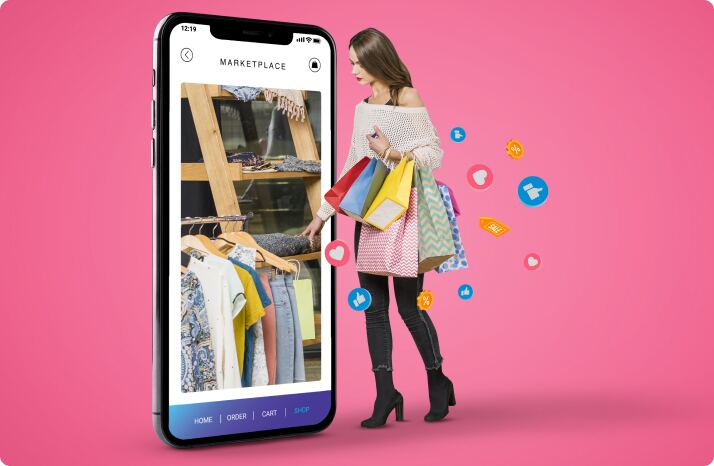Instagram eCommerce: Everything You Need to Know
- February 6, 2024
- 12 mins read
- Listen

Table of Content
Instagram started in 2010 as a photo-sharing app, but it quickly evolved into a platform for global businesses and buyers to connect. The platform has become an eCommerce hub. With the millennial crowd taking over a large portion of buyer percentage, retailers must have their footprints in Instagram eCommerce.
According to Oberlo (2023) over 70% of shoppers use Instagram to discover new products. Another Wordsteam ( 2024) report shows that 95% of users follow businesses on Instagram. This data indicates the significance of this social platform on eCommerce dynamics.
If you need to become more familiar with the term, and wondering – what is Instagram eCommerce? – Instagram eCommerce essentially involves using the platform for Shop and Sale purposes. Consumers engage in product research, identify prospective buyers, and conduct transactions directly via Instagram. Meanwhile, merchants utilize shopping features, exhibit their products, and connect with their target market. These processes form the foundation of eCommerce within Instagram.
How to Use Instagram for eCommerce?
Before getting started, get these questions. So you will understand your target audiences better and tailor your strategies accordingly.
- Who is your ideal customer and what are their needs?
- What products or services are you selling and how do they fit the Instagram market?
- What are your goals and resources for Instagram eCommerce?
Follow the next steps if you are new to the sector.
1. Instagram eCommerce Eligibility Requirements
Here are the key Instagram commerce eligibility requirements you need to meet to sell on Instagram:
a. Comply with Instagram’s policies: This means adhering to Instagram’s Terms of Use, Community Guidelines, Commerce Product Merchant Agreement, Commerce Policy, and Instagram Ad Policy.
These policies outline what is and isn’t allowed on the platform, including product restrictions, prohibited content, and advertising practices.
b. Represent your business and domain: You can only tag products from a website that you own and operate. This means no linking to products on other platforms like Amazon or Redbubble. You can, however, connect your Instagram shop to an approved e-commerce platform like Shopify or BigCommerce, as long as it’s connected to your Facebook account.
Your Instagram profile should accurately represent your business and brand. This includes using a professional profile picture and bio and having a consistent visual aesthetic throughout your feed.
c. Be located in a supported market: Instagram Shopping is not available in all countries. You can check the latest list of supported markets on the Instagram Business Help Center.
d. Demonstrate trustworthiness: Your Instagram account should have an established presence and demonstrate trustworthiness. This includes having a decent number of followers (although Instagram doesn’t specify an exact number), consistent engagement with your audience, and positive reviews.
e. Provide accurate information and follow best practices: Make sure your product descriptions, pricing, and shipping information are accurate and up-to-date. Use high-quality product photos and videos that showcase your products well.
2. Set up an Instagram Shop
Setting up Instagram shopping can be a great way to reach new customers and boost your sales. Here’s a step-by-step guide on how to get started:
a. Meet The Requirements
Before you start, make sure you meet the following requirements:
- Have a business or creator Instagram account.
- Comply with Instagram’s commerce policies.
- Have a Facebook page or Business Manager account.
- Have a product catalog connected to your Facebook Shop.
b. Set up Your Facebook Shop:
Here is a guide on how to create a Facebook page.
c. Connect Your Facebook Shop to Instagram
Once your Facebook shop is set up, you can connect it to your Instagram account. This will allow you to tag products in your posts and stories.
To connect,
- Go to inbox and find Instagram tab
- Connect Instagram account
- Allow Instagram Access
- Select the account you want to continue your shopping with
Now the platform may ask you to choose a creator or business. You can choose either according to your needs. They both are professional accounts.
Select the category of your shop and find your Instagram connected to the meta business suite. now, click done.
Next,
- Go to all tools on the left of the meta business suite.
- You have to select the commerce tab. This will bring you to ‘ Sell on Facebook, Instagram, or both.”- Get started once you see this.
- You will get two things – create a catalog or create a shop -select shop.
- Follow the instructions and fill in the requirements.
Woohoo! Your Instagram shop is ready.
3. Design Your Instagram Shop
Once your shop is technically ready, you have to plan the visual design. Four things are very important for successful Instagram shops – visual cohesiveness, quality product photos, quality product presentation, and user experience. Let’s give some pro tips to excel each one of them gracefully.
- Visual Cohesiveness
Maintain a consistent color palette and theme. Choose colors that reflect your brand identity and resonate with your target audience. Stick to this palette throughout your product photos, backgrounds, and graphics for a unified look.
- Quality Product Photos
You should invest in professional product photography that showcases your items in the best light. Ensure consistent lighting, backgrounds, and angles for a polished look. Utilize templates or design tools to ensure consistent style and professionalism.
- Product Presentation
Use clear and concise descriptions that emphasize the benefits and unique selling points of your products. Create collections or categories to organize your products and make them easily discoverable by customers.
- User Experience
It is important for any commerce model. Your buyers should be able to find their desired products easily. Also, the purchase, payment, and delivery channels have to be smooth. Tag your products in organic posts and Stories to make them directly shoppable, streamlining the buying journey.
4. Marketing Strategy for Instagram Shop
Here we are at the biggest step, setting marketing strategies for Instagram eCommerce.
- Target Audience: Understand your ideal customer’s age, gender, location, interests, and buying behaviors. This helps tailor your content and messaging for maximum impact.
- Content Planning: Select the types of content your visitors will love based on the target audience demographic studies. Show how your products fit into everyday life. User-generated content (UGC) is an excellent way to achieve this.
- Content Format: Instagram has different content format options for users. Utilize Reels, Stories, Highlights, and Lives to keep your content fresh and dynamic. Make sure you post each type of content deliberately throughout the week.
- Content Calendar: A content calendar is important to ensure the distribution of your content in the most engaging times. Also, you can leverage special occasions to your marketing strategy with the help of a calendar.
- Paid ads: If you are planning to run paid ads, plan the budget and target audiences upfront. So, you will not miss out on things in the long run.
The Benefits of Using Instagram for eCommerce
Instagram stands out for its visual-centric approach and highly engaged user base. Let’s learn why Instagram is a game-changer for eCommerce.
1. Sell Directly on Instagram
Instagram offers eCommerce businesses a direct path to boost sales and simplify the buying process for customers. With features like shoppable posts and Instagram checkout, businesses can sell products directly on the platform. This makes it easier for customers to make purchases and increases conversion rates.
2. Reach Users With High-purchase Intent
You can engage users frequently with content related to products they’re interested in. You can make Instagram a goldmine for your businesses to connect with eager shoppers. By strategically targeting demographics and interests, businesses can effectively reach potential customers who are primed to convert.
3. Business-to-Consumer Marketing (B2C)
Instagram provides an unparalleled opportunity for brands to showcase their products in captivating ways. It fosters genuine connections through interactive features like comments and direct messages and cultivates a loyal customer base.
4. Cost-Effective Marketing
Compared to traditional advertising channels, Instagram offers cost-effective marketing options, especially for small and medium-sized businesses. The Ads Manager gives businesses everything they need to succeed online. You can set how much money you want to spend, choose who sees your ads, and see how well your ads are doing immediately. It’s like having a control panel for your advertising on Instagram.
5. Track Performance and Metrics
With Instagram’s analytics, businesses can see which posts, stories, or ads are grabbing people’s attention and which ones are falling flat. This information helps them fine-tune their content strategy for maximum impact.
6 Proven Strategies for Instagram eCommerce Success
With over a billion active users, Instagram offers a wealth of opportunities for eCommerce success. Below are six proven strategies for Instagram eCommerce success,
1. Use Hashtags
Posts with 11 or more hashtags witness a 79.5% surge in interactions compared to those without any hashtags, especially evident for smaller accounts with less than 1,000 followers, according to data from Search Logistics.
Include hashtags in your Instagram eCommerce strategy. Use them to increase the discoverability of your products. Research relevant and trending hashtags in your industry and incorporate them into your posts to expand your reach. It will attract more potential customers.
2. Respond to Comments
Engage with your audience by responding promptly to comments on your posts. Respond kindly to positive comments, answer any questions or worries, and have genuine conversations to create trust and loyalty with your followers.
3. Use a Chatbot
Implement an AI-powered chatbot to streamline customer inquiries and provide instant feedback. A chatbot can help automate responses to frequently asked questions. It also guides customers through the purchasing process and enhances the overall user experience.
4. User-Generated Content
Encourage your customers to create and share content featuring your products. User-generated content serves as authentic testimonials and social proof. It boosts credibility and influences the purchasing decisions of potential buyers.
5. Influencer Marketing
According to the Influencer Marketing Hub Benchmark Report, close to 60% of marketers intend to boost their budget for influencer marketing in 2024, with a portion allocating more than 40% of their overall marketing budget to this strategy.
Partner with influencers in your niche to promote your products to their followers. Collaborating with influencers who align with your brand values can significantly expand your reach. It will drive traffic to your eCommerce store, and generate more sales.
6. Consistent Branding
Maintain a consistent aesthetic and brand voice across your Instagram posts and stories. Establishing a cohesive visual identity helps reinforce brand recognition. It builds trust in your audience and differentiates your eCommerce business from competitors.
Top Seven Instagram eCommerce Tools
Whether you’re a small boutique or a large retailer, incorporating these tools for e-commerce into your Instagram strategy can give you a competitive edge in the ever-evolving world of online commerce.
1. Like2Buy – Create Shoppable Links
An e-commerce business can create shoppable links on Instagram. One platform is Like2Buy. This tool allows users to create functional product tag templates to promote products from their feeds. These templates include images, prices, tags, and user comments. They can add hashtags, custom fonts, and other assets to make their content look more professional.
2. Ritetag – Find The Best Hashtags for Your Content
Ritetag is a free social media tool designed to help users find the best hashtags for their content on networks such as Instagram, Facebook, and Twitter.
With the help of Ritetag and other Instagram scraper tools, users can quickly analyze hashtags and determine if they’re being used appropriately or overused. This trait gives them valuable insight into which hashtags are most effective for promoting online content.
3. NapoleonCat: Analyze Competitors on Instagram
NapoleonCat provides e-commerce businesses with an online presence and analytics tools to track competitors on Instagram. You can access the relevant social media tools free of cost. These tools help you analyze your audience’s behavior, content, and hashtags
With NapoleonCat, you can automatically protect your different Instagram account categories from spam and hate comments. This feature helps curb bad reviews and avoid any negative publicity
4. Canva – Great Graphics Don’t Require Experience
Canva, a popular e-commerce editing tool, can create beautiful graphics within minutes. It has templates for social media posts, blog posts, ads, and more, with the option to customize content to make it unique. Canva helps you to generate Instagram posts using AI.
With its free version, you can create graphics using shapes and text, while its paid version offers more features like e-commerce templates, advanced photo editing tools, and other specialty services.
5. Photoslurp – Quickly Collects All UGC Content
Photoslurp is a social media automation platform that allows businesses to easily collect, curate, and analyze user-generated content (UGC) on social media platforms such as Instagram, Facebook, and Twitter. The platform offers many features to help businesses collect, curate, and analyze UGC effectively. It provides tools for app marketing, e-commerce, analytics, and outreach.
6. Wishpond – Rock Instagram Contests
With Wishpond, users can create Instagram contests for engagement, followers, and word-of-mouth marketing. It offers various features to manage and track contest campaigns on a single platform.
Hashtag contests involve users submitting content with a designated hashtag for the contest. These features make it easy for users to participate and vote on the best content.
7. Auto-Moderation – Shield Your Instagram From Spam & Hate
Auto-moderation is a powerful tool that can be used to protect your Instagram account from spam and hate speech. This feature automatically hides or deletes comments that may be considered spam or hateful. With this feature, you can have posts auto-moderated on a schedule or manually review comments before they’re visible on your feed.
End Note
How social media affects marketing? Are you looking to revamp your eCommerce strategies? Make Instagram your on-the-go platform. Instagram is an excellent platform when you have social media on top of your marketing strategies. In the future, Instagram combining social media and shopping will offer great chances for businesses to do well and for people to find, interact with, and buy things in more personalized and engaging ways.
Want to know more on how social media can help your business to flourish? Check out our other blog on ‘how social media affects marketing?’





